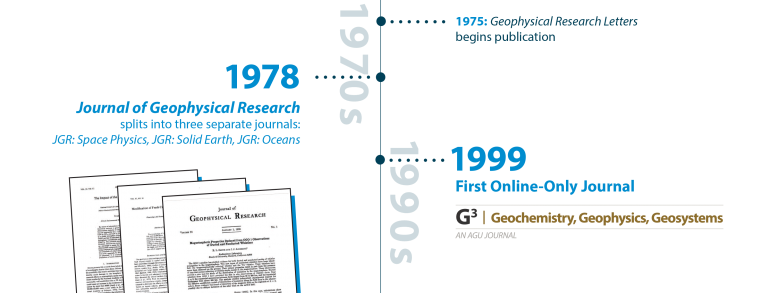By Vicki Zwart
The American Geophysical Union’s first publication – Transactions – was a catch-all during the early days of the society, publishing research papers, minutes from Executive Committee meetings, and news from the geophysics community on a bimonthly basis. It was not until the explosion of research during the International Geophysical Year in 1958 that the Union’s leadership realized their current format needed an upgrade and fast. In the Report of Special Committee on Publications, in Transactions, Vol. 39, no. 4, chairman J. A. Peoples, Jr. wrote that the Union needed “a larger and better balanced journal where the results of the geophysical investigations can be published promptly.”
While original plans had AGU creating its own new scientific journal called Research in Geophysics, a modified journal took shape instead, by combining with the already-established Journal of Geophysical Research. In January 1959, with approval from the National Academy of Sciences and Union membership, two co-editors quickly got to work with a goal of 200 pages of scientific material a month within one to two years. Content would include original research reports from all geophysics fields with those providing “insight into the interrelationships of the different fields” especially desirable, along with critical reviews of geophysical developments, a Letters department, meeting abstracts and advertising.
Three years later, JGR was already experiencing serious growing pains, publishing 500 pages an issue; a semi-monthly publication schedule began in January 1963. The editors refused to split the content subject-wise, writing in Transactions, Vol. 44, no. 1, that “geophysics is already a fragmented science.” In January 1964, however, subject matter was divided – Space and Aeronomy in one issue and the rest of geophysics in the other. The trend continued in 1969 when the “red” issue of JGR (mid-month version) was subdivided into Solid Earth & Planets and Oceanography and Meteorology.
Factoids
In 1949, Merle A. Tuve, the Director of the Department of Terrestrial Magnetism of the Carnegie Institution of Washington, proposed that AGU take over publishing the journal he edited – Journal of Geophysical Research (JGR). He suggested that the more fundamental papers that appeared in Transactions would be submitted for publication in JGR and Transactions would still publish in a reduced size. The Union’s Executive Committee decided to put the idea on hold due to financial concerns.
H. Abelson, Director of the Geophysical Laboratory of the Carnegie Institution, and James A. Peoples, Professor of Geophysics at the University of Kansas, served jointly as the first editors of JGR.
To finance JGR, suggestions included: Dues be raised from $8 to $10, a page charge of $15 be assessed from authors’ institutions, a subscription rate of $16 a year be established, and a grant of $50,000 be solicited to help with the first three years of publication.
By 1988, there were 4 versions of JGR: Space Physics, Solid Earth and Planets, Oceans, and Atmospheres. JGR-Planets was spun off in 1993.



